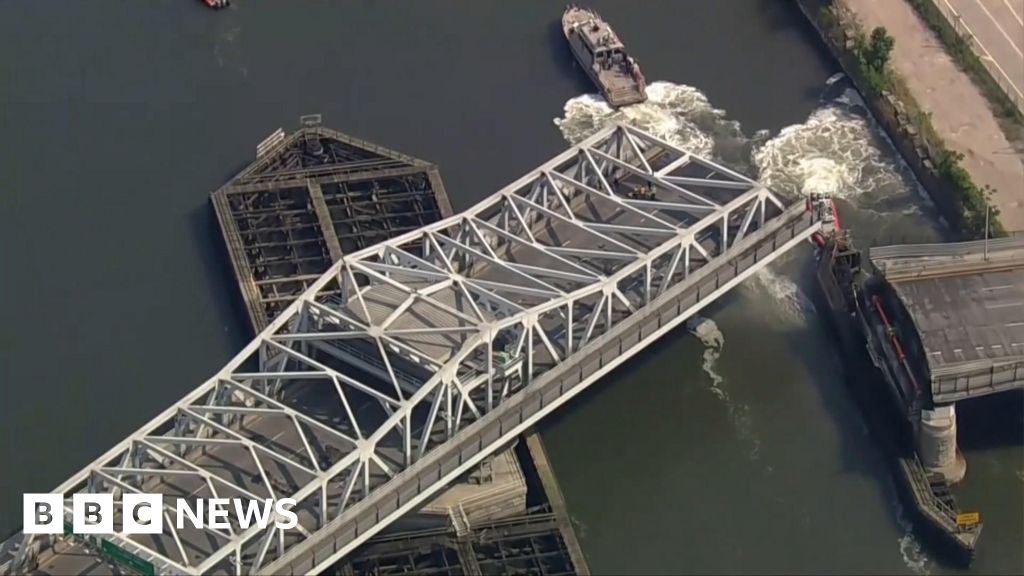- cross-posted to:
- klimawandel
- cross-posted to:
- klimawandel
Third Avenue Bridge, which connects New York’s the Bronx to Manhattan, got stuck in an open position due to the high heat on Monday.
FDNY officers arrived in boats and fired water at the structure to try and cool down the metal, which expanded after high temperatures in the city, officials say.
The incident caused major traffic delays during one of the hottest days of the year in New York but reopened on the same day.



Not a bridge expert, or really any kind of expert, really. But railroad rails are laid with a little gap to account for thermal expansion of the rail on hot days. If the expansion is more than designed for, you get buckling like this. This bridge was probably also designed to account for thermal expansion to a certain degree. It seems like more and more of our infrastructure is starting to fail, encountering heat levels it was never expected to encounter. I wonder if failures like this and worse are going to become a common headline
Bridge engineer here (not much experience, so I wouldn’t consider myself an expert, but I have more knowledge about it than the general public).
Your suspicions are correct, bridges are designed for thermal expansion. More of our infrastructure is starting to fail, and part of that is because it’s experiencing climate it was never designed for (heat, sea level rise, more drastic storm surges, etc). I would fully expect this to be a more common headline. At least for several more years, anyway. If the federal money from the infrastructure bill the US passed a few years ago runs out or is not allocated to the right structures, then this will only get more common. I don’t expect the Trump administration to champion an extension of these funds if they do run out. It was passed under Biden, after all.
As for this bridge in particular, this is a moveable steel bridge. The fact that it’s moveable means it is particularly sensitive to expansion (as well as salinity which causes rusting). Too much expansion, and the steel will get stuck in one position. In a typical steel bridge, if the thermal expansion exceeds what it was designed for, you end up getting higher stress levels in the steel as it pushes harder against the abutments. Usually this is alright in the short term, since we design these to withstand much higher stresses than it will ever likely experience. Repeated cycles of this, however, will cause fatigue failure (think of a paperclip or metal spoon snapping after you bend it back and forth a bunch).
Anyways, there you have it. I rambled for too long about this lol.
The fuck you did! Making the world a little less dumb, one ramble at a time, is a good thing. We don’t all need to be specialists in everything, but a brief summary like this contributes to our general knowledge and is a net positive.
Thanks for this additional info; your comment was interesting
No problem! I just like bridges and sometimes can’t help myself lol.
Do you have a favourite bridge?
Edit: I don’t know many bridges, but I quite like the Millennium Bridge in Gateshead. (https://en.m.wikipedia.org/wiki/Gateshead_Millennium_Bridge) My dad took me and my siblings there when it opened. It was a big deal for the area and I was young enough to not understand why, so I looked at it real hard to try to understand why everyone was so hyped. I concluded that it was a pretty good bridge.
Hank?
According to Practical Engineering, tracks are no longer given a gap. The gap causes premature wear and excess noise. Instead, they lay the track under tension, and weld the joins between sections.
There is still a limit on how much heat they can handle before buckling, of course. I just thought that was a neat innovation.
That sounds crazy. How do they do it? Just lay the rails on a hot day?
Basically, yes, though I think they have special hydraulic pullers, too. I forget the exact name. They have to take special measures if the day is too cold.
https://youtu.be/zqmOSMAtadc?si=FCG7HxiPWXNQY6Uj
Rail is laid at a “neutral temperature” calculated from the min and max temperatures of an area. They want the rail to not pull apart in the cold or buckle in the heat. If average temperatures go up that calculated neutral temperature goes up so rail laid at a lower neutral temperature are more likely to buckle.